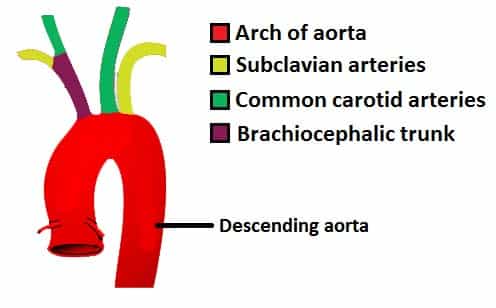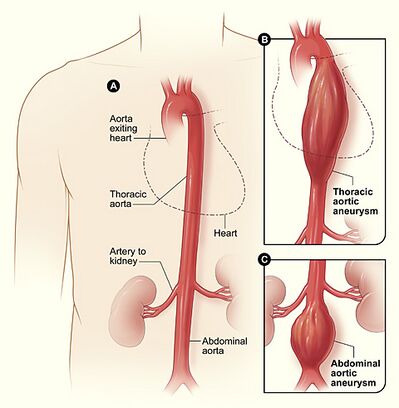The Aorta Is Classified as One of These Vessels
It provides blood to the muscles of the chest wall and the spinal cord. Along the way blood vessels branch off the aorta extending to.

The Aorta Branches Aortic Arch Teachmeanatomy
The thoracic aorta runs from the aortic arch to the diaphragm which is the point of separation between the chest cavity and the abdominal cavity.

. Branches from the abdominal aorta into the left gastric hepatic and splenic arteries. 191 204 The transition from ascending aorta to aortic. The aorta can be divided into four sections.
The large vein that returns deoxygenated blood from the lower extremities and the abdomen to the right atrium of. It runs through a common pericardial sheath with the pulmonary trunkThese two blood vessels twist around each other causing the aorta to start out posterior to the pulmonary trunk but end by twisting to its right and anterior side. The aorta is a large cane-shaped vessel that delivers oxygen-rich blood to your body.
Supplies blood to the stomach spleen and pancreas. The venules and veins returning blood to the heart. The aorta and its branches.
The type of blood vessel is an arteryThe largest an elastic one connected to. The aortic arches also known as the pharyngeal arch arteries are six pairs of embryologic vascular structures that give rise to the great arteries of the head and neck including parts of the common carotid arteries internal carotid arteries maxillary arteries aortic arch pulmonary arteries right subclavian artery ductus arteriosus stapedial arteries and hyoid artery. The pulmonary arteries the aorta and its branches together comprise the bodys system of elastic arteries.
It terminates at the level of L4 by bifurcating into the left and right common iliac arteries. Supplies blood to the esophagus and portions of the stomach. 1 Which of the following blood vessels is a direct branch of the ascending aorta.
The aorta classified as a large elastic artery and more information on its internal structure can be found here. The ascending aorta the aortic arch the thoracic descending aorta and the abdominal aorta. The peripheral vascular system is classified as follows.
The ascending aorta is the first of the four regions. The first vessels that branch from the ascending aorta are the paired coronary arteries see Figure 2025 which arise from two of the three sinuses in the ascending aorta just superior to the aortic semilunar valveThese sinuses contain the aortic baroreceptors and chemoreceptors critical to maintain cardiac function. The beginning of this region is marked by the aortic valve of the heart and just beneath it the aorta has three small orifices known as aortic sinuses.
The abdominal aorta runs from the diaphragm and ends just above the pelvis where it divides into the iliac arteries. The function and structure of each segment of the peripheral vascular system vary depending on. Venules drain these tiny vessels.
The aberrant vessel may course posterior to the aorta retroaorta or between the ascending aorta and pulmonary artery interarterial prepulmonary artery prepulmonic or septal subpulmonic. Of the following arteries the one involved in the make-up of the circle of willis is the. In the ascending aorta the blood has a high pressure as it exits from the left ventricle due to its strong contraction.
Reset Help capillaries The aorta is classified as one of these vessels veins These vessels have thinner walls and transport oxygen-poor blood arteries Blood pressure in these vessels is low or even negative These vessels have thicker walls and a heavier tunica media Some of these larger vessels have valves to prevent backflovw Superior and inferior vena cava are classified as. It starts in the lower-left part of the heart and passes through the chest and abdomen. Nutrient and gas exchange occur in these vessels.
The peripheral vascular system PVS includes all the blood vessels that exist outside the heart. There are three major branches of the aortic arch. 3 6 7 Although the interarterial subtype is extremely rare this subtype of patient may present.
Supplies blood to the liver. The aorta is classified as one of these vessels. There are four subtypes based on the anatomic course of the aortic artery.
In these large arteries the amount of elastic tissue is considerable and the smooth muscle fiber cells are arranged in 5 to 7 layers in both circular and longitudinal directions. The walls of large blood vessels like the aorta and the vena cava are supplied with blood by vasa vasorum. What kind of blood vessel carries blood away from the heart.
This term translates to mean vessel of a vessel Three types of vasa vasorum exist 1 vasa vasorum internae 2 vasa vasorum externae and. As you would expect based upon proximity to the heart each of these vessels is. These vessels have thicker walls and a heavier tunica media.
What are the 4 portions of the temporal bone. The average volume of blood in an adult human body is. Look at the coronary vasculature in the heart power point A right subclavian artery B carotid artery C right coronary artery D left coronary artery E both the right and left coronary arteries.
The brachiocephalic artery the left common carotid artery and the left subclavian literally under the clavicle artery. The ascending aorta begins at the opening of the aortic valve in the left ventricle of the heart. Thoracic Aorta Chest Region.


No comments for "The Aorta Is Classified as One of These Vessels"
Post a Comment